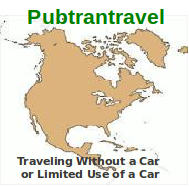
Traveling Via Public Transportation
In
North America
Train-Bus-Ferry-Tour-Bicycle-Walk-Car
Share-Taxi

 |
Traveling Via Public Transportation
In
North America |
|
|
Home - Why Travel Via Public Transportation - How to use Public Transportation – Contact Us – Search |
|
Resources Why Travel Via Public Transportation |
Car Free Living – Duluth By Steve Atlas Duluth, Minnesota Duluth, with a population of 98,000, is great mid-sized city to live. It’s a tourist destination and wonderful place to live all year round. The city climbs to 500 feet above Lake Superior with most of the city built on the hillside where lake views are splendid. Duluth is a regional medical center, has four colleges, its own symphony orchestra, international shipping and a thriving tourist business. Duluth offers acres of green park space, sailing, a regional Spirit Mountain ski facility, hiking and biking trails, two 27-hole public golf courses and two private 18-hole clubs. The city also has miles of intercity beaches on Park Point and 14 trout streams within the city limits that flow into Lake Superior.
In winter, it’s warmer by the lake. Winter in Duluth can be cold and snowy; but there’s plenty to do like skiing, skating and snowmobiling or just getting cozy by the fireplace. More information about Duluth Minnesota is available at www.visitduluth.com or http://en.wikipedia.org/wiki/Duluth, Minnesota If you want to work, go to college or retire to a city where you won’t need a car, Duluth is a great place to live. The city is located on the western most tip of Lake Superior and is laid out in a narrow and long geographical configuration - 3 miles wide and 30 miles long. Eighty-five percent of the city’s population lives within 3 blocks of a DTA bus line and Duluth Transit Authority (DTA) routes provide service, seven days a week, to most neighborhoods in the city. DTA fares are low and you can get just about anywhere on the bus. DTA fares for college students in Duluth are free through the DTA’s unlimited-ride U-PASS Program.
Where is public transportation available? Duluth and Proctor, Minnesota; Superior, Wisconsin
What specific transit routes operate seven days a week? Routes 1, 2, 3, 6, 7, 9, 10, 11, 13, 16, and 17 operate seven days a week
The DTA also operates a downtown Trolley during the summer months that circulates daily between downtown Duluth, Canal Park and the Bayfront.
Two Neighborhoods are good choices for car-free livingIn addition to the many neighborhoods in the DTA service area (listed above) that have daily and late night bus service the following are the best choices for anyone who doesn’t want to depend on a car:
This area of town includes a mix of student and family dwellings, with a variety of historic homes and senior apartments. This neighborhood also includes the University of Minnesota, Duluth (UMD), the College of St. Scholastica and the Duluth Medical Corridor, which includes three hospitals and two clinics. East Hillside has great DTA service, with six bus routes operating seven days a week throughout the neighborhood, along with late night service available on several routes serving the area. Bus riders living in East Hillside enjoy easy access to downtown shopping and entertainment centers, cultural events at UMD and neighborhood retail centers. It’s easy to connect to buses serving the Miller Hill Mall – Duluth’s largest retail mall area – and the Duluth International Airport. .
This neighborhood is primarily residential with a mix of family and senior complexes. West Duluth is located along the DTA’s mainline route, which provides frequent daily and late night bus service. West Duluth is home to many “main street” stores, retail centers and Duluth Huskies professional baseball team. Residents of West Duluth enjoy direct service to downtown shopping and entertainment centers, the Miller Hill Mall retail district, Duluth International Airport, UMD, Lake Superior College, neighborhood retail centers and the Greyhound Bus Depot.
Duluth Transit Buses go almost anywhere you want to goPublic transportation is an easy and very affordable way to get anywhere in Duluth, Proctor, or Superior.
Duluth is a good place to retire—but beware of the cold wintersAffordable housing (much less costly than big cities), and the convenience and quality of Duluth Transit buses make Duluth a good place to retire. However, if cold winters are a concern, retirees may want to go away for the winter or just enjoy Duluth as visitors.
What You Need to Know City or Region: Duluth, MinnesotaPopulation: City of Duluth: 98,000; Metro region: 160,000
Name of Transit Provider: Duluth Transit Authority (DTA) Phone Number: 218/722-SAVE (7283)Customer Service Phone Hours: 6 a.m. –7 p.m. Monday-Friday 8 a.m. – 7 p.m. –Saturday 8 a.m. – 6 p.m. Sunday Automated information available 24 hours a day during non-business hours. Web Site: www.duluthtransit.com:
Days and Hours Transit Service Operates: Monday-Friday: 6 a.m. – midnight Saturday: 7 a.m. –8 p.m., Sunday: 7 a.m. – 6 p.m.
Where is the nearest Airport? Is it served by public transit?? Duluth International Airport, in Duluth Heights is served everyday by Routes 5 and 10
Where is the nearest Bus Terminal? Is it served by local transit? The Greyhound bus terminal, at 46th Ave. West and Grand, is served by routes 1, 2, 3, 4, and 5. (Routes 1, 2, and 3 operate seven days a week.)
|
New At Pubtrantravel Pubtrantravel welcomes Steve Atlas founder of carfreeamerica.org as its newest contributing writer. 20 Beaches You Can Enjoy Without a Car By Steve Atlas Vacation Destinations You Can Enjoy Without a Car By Steve Atlas Locations where it is possible to live without or with limited use of a car By Steve Atlas |